The rosemary buns with sourdough are sweet buns found in Florentine bakeries during the Easter period. More precisely, they are “THE” dessert to absolutely eat on Holy Thursday, an expression of a humble cuisine where creativity and recycling reign. They are, in fact, sweet buns made by enriching the dough of “sciocco” bread with more substantial and delicious ingredients. They thus result in a mix between sweet and savory, with the aroma of rosemary (the ramerino of the name) combined with raisins, making them perfect for snack, or a treat after a meal but also for a continental breakfast. In this version of mine, I tried to reproduce the ones I used to eat from the baker around the corner, with a light hint of anise and the glaze that made my fingers sticky. If you want to try, put on your apron!
At the end of the recipe, you will find the link to the gluten-free rosemary buns made by my friend and colleague Selene from the blog ViaggiandoMangiando80 because such a delight must be enjoyed by everyone!
For other traditional Tuscan sweet recipes take a look here

- Difficulty: Medium
- Cost: Economical
- Rest time: 10 Hours
- Preparation time: 40 Minutes
- Portions: 13
- Cooking methods: Oven
- Cuisine: Regional Italian
- Region: Tuscany
- Seasonality: Easter, Spring, Summer and Autumn
Ingredients
The basic ingredients are those needed to make bread. Additionally, there’s a small amount of sugar and milk along with raisins and rosemary. You can use any type of flour with different levels of refinement, being careful about the different hydration needs. For example, I also made them with Grangusto type 1 flour from Molino Colombo and in this case, I added 30 g more of water.
- 3 1/4 cups all-purpose flour
- 2/3 cup sourdough
- 3 1/2 tbsp milk (also plant-based)
- 3/4 cup water
- 1/4 cup sugar
- 1 1/4 tsp salt
- 1 cup Malaga-type raisins
- 1/2 cup Vin Santo
- 6 1/2 tbsp extra virgin olive oil
- 3/4 oz rosemary (fresh)
- 1 tsp black anise (seeds)
- 1 egg yolk
- 2 tbsp milk
- 1/4 cup sugar
- 1/4 cup water
Tools
- 1 Stand Mixer
- 1 Small Pot
- 1 Strainer
- 1 Knife
- 1 Bowl
- 1 Plastic Wrap
- 1 Work Surface
- 1 Metal Scraper
- 1 Food Scale
- 2 Brushes
- 2 Baking Trays
- 1 Small Pot
- 1 Cooling Rack
- 1 Bread Scoring Knife
Steps
Preparing Rosemary Buns with Sourdough isn’t difficult, they’re just a bit laborious, like all preparations with sourdough. Creating a kind of schedule can help a lot to avoid “getting stuck” with the sourdough timing and your daily routine. For example, I refresh at noon, knead around 5 PM, and after a couple of hours, I put it in the fridge until the next day, as these timings allow me to manage everything else as well.
In the stand mixer, break the sourdough into the milk. With the paddle attachment, run the mixer at moderate speed until the sourdough is completely dissolved, forming a milky and thick liquid.
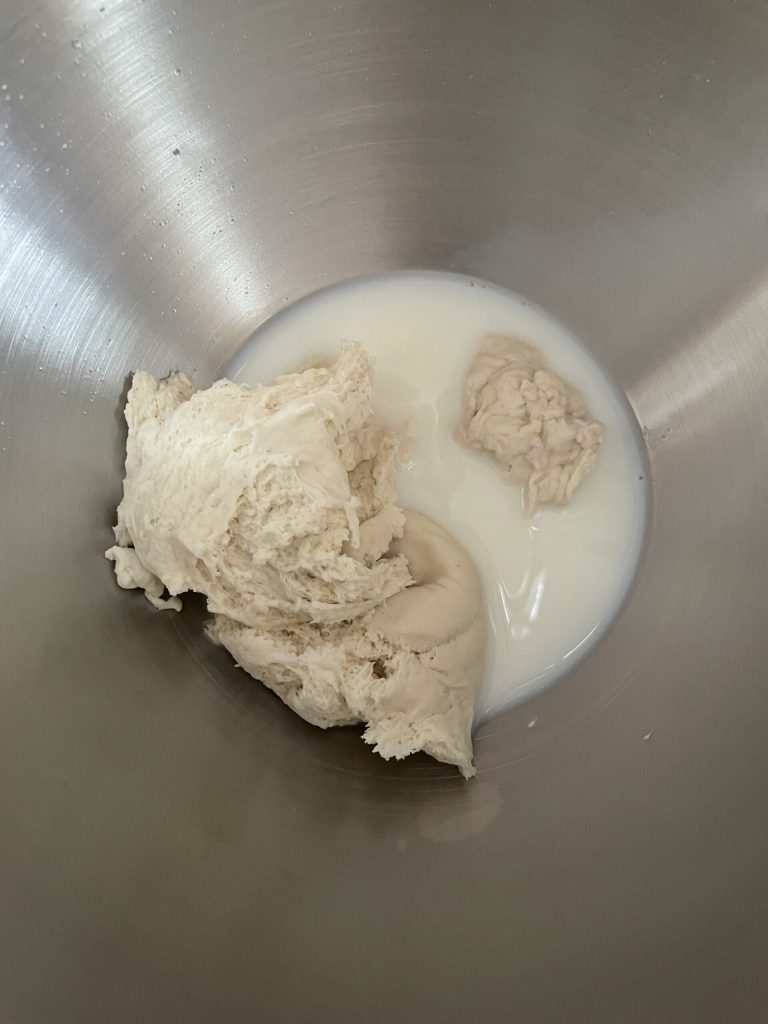
Gradually add the flour alternating with water, at least in three parts, making sure the water is absorbed before the next addition.
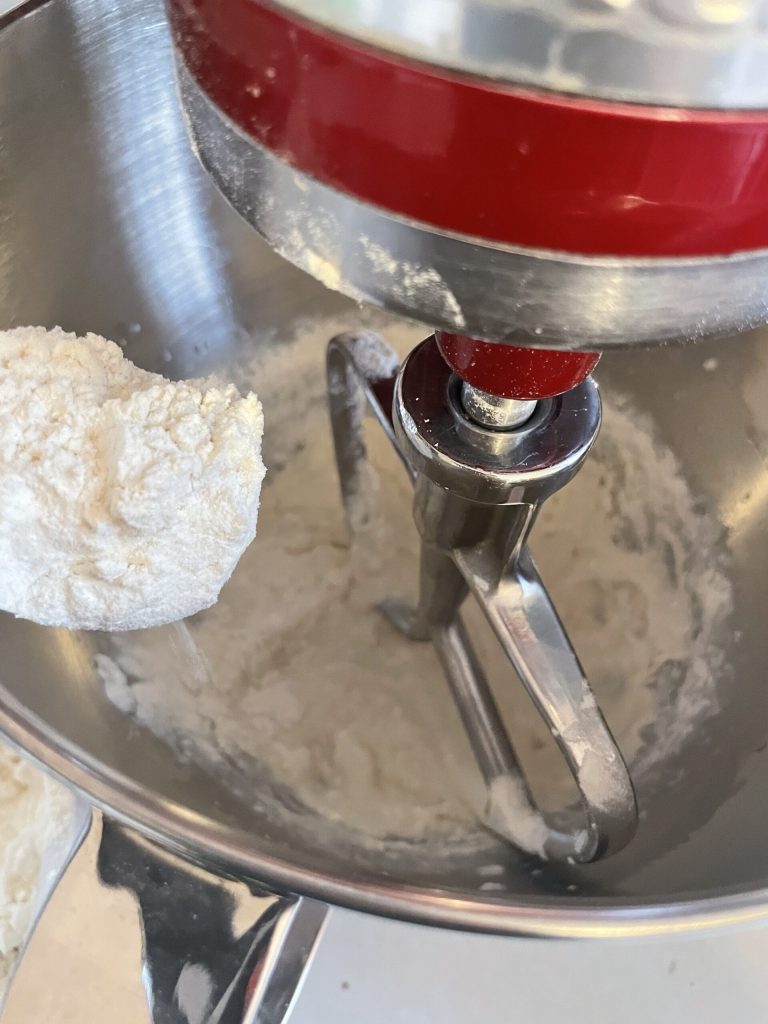
After adding all the flour and once the dough has gained some firmness, add the sugar. The dough will be very thick and compact; when you start seeing the mixer straining, switch to the dough hook to continue with the next steps.
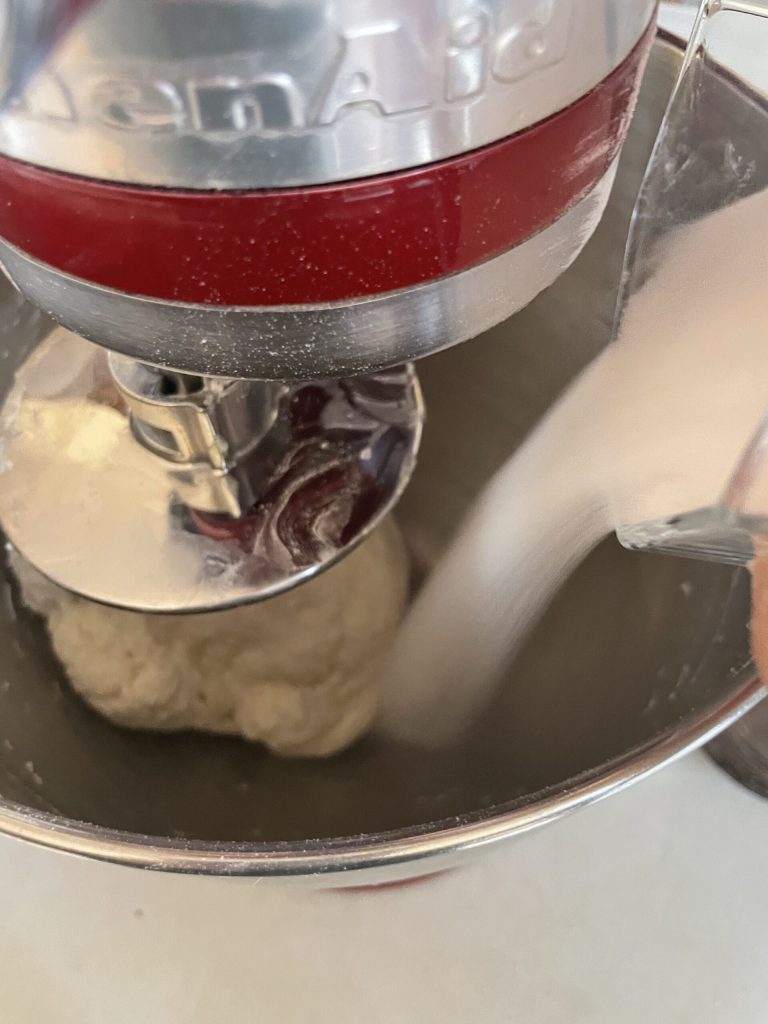
Before starting to knead, it’s necessary to heat the oil with half of the rosemary in a small pot. It shouldn’t fry; when bubbles start to appear, my advice is to turn it off and let it cool with the rosemary still inside. Strain it with a sieve shortly before using.
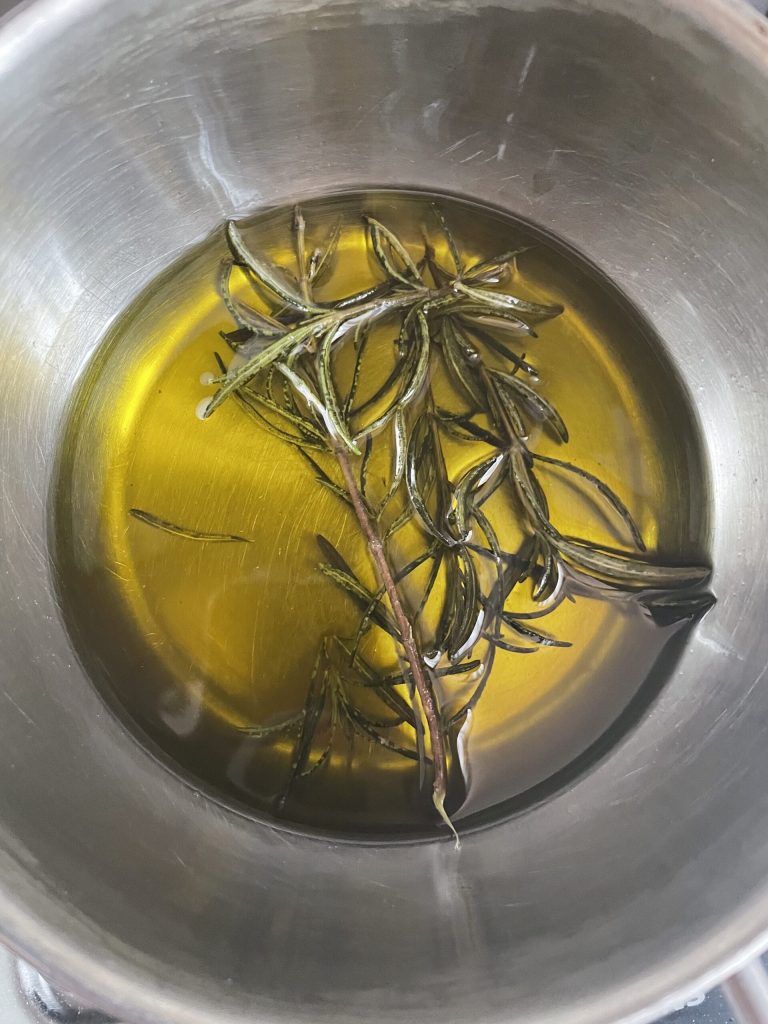
Once well cooled, add the oil in three parts to the dough, with the mixer at medium-high speed.
As soon as it binds, add the salt and increase the speed to complete binding.
At this point, you can choose to stop, let it rise, and then the next day add the inclusions or (I prefer) add them now and let the complete dough rest afterward.
This way, it will have time to absorb all the aromas you are going to add.
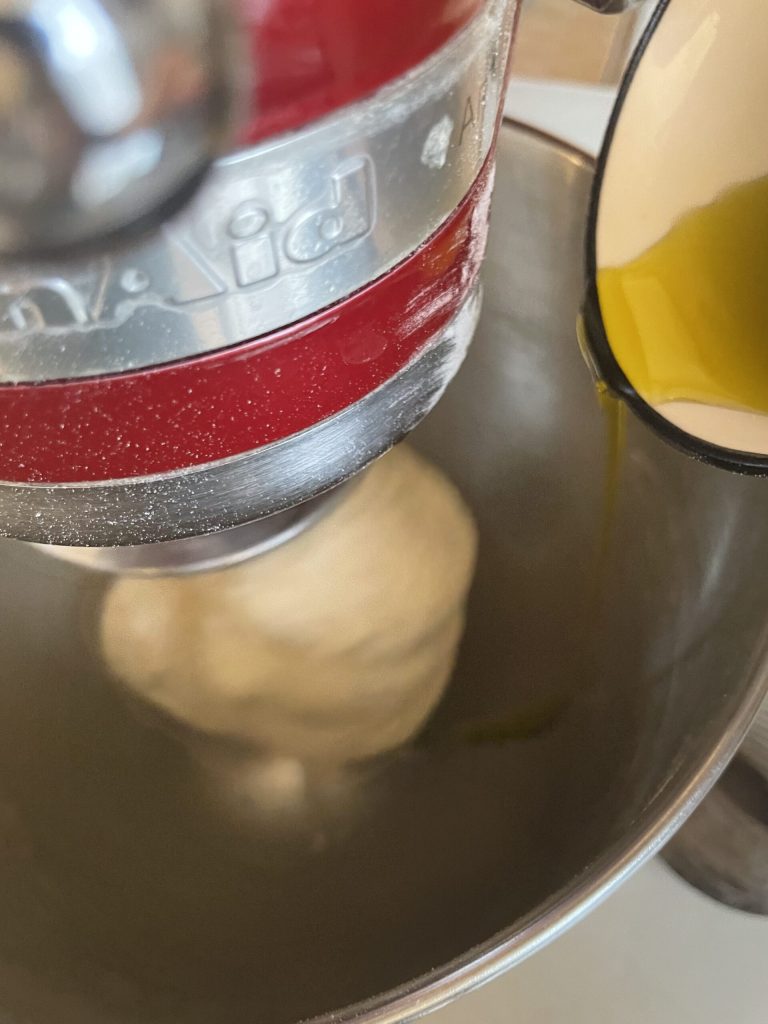
Then finely chop the remaining fresh rosemary with a sharp knife and add it to the dough gradually to maintain the structure of the mass.

Lastly, add the raisins that have been previously rehydrated in Vin Santo and squeezed, along with a bit of anise. The latter is not a mandatory ingredient like rosemary and raisins; but in my childhood memories, it’s there, and I love its aroma. Obviously, if you don’t like it, you can omit it.
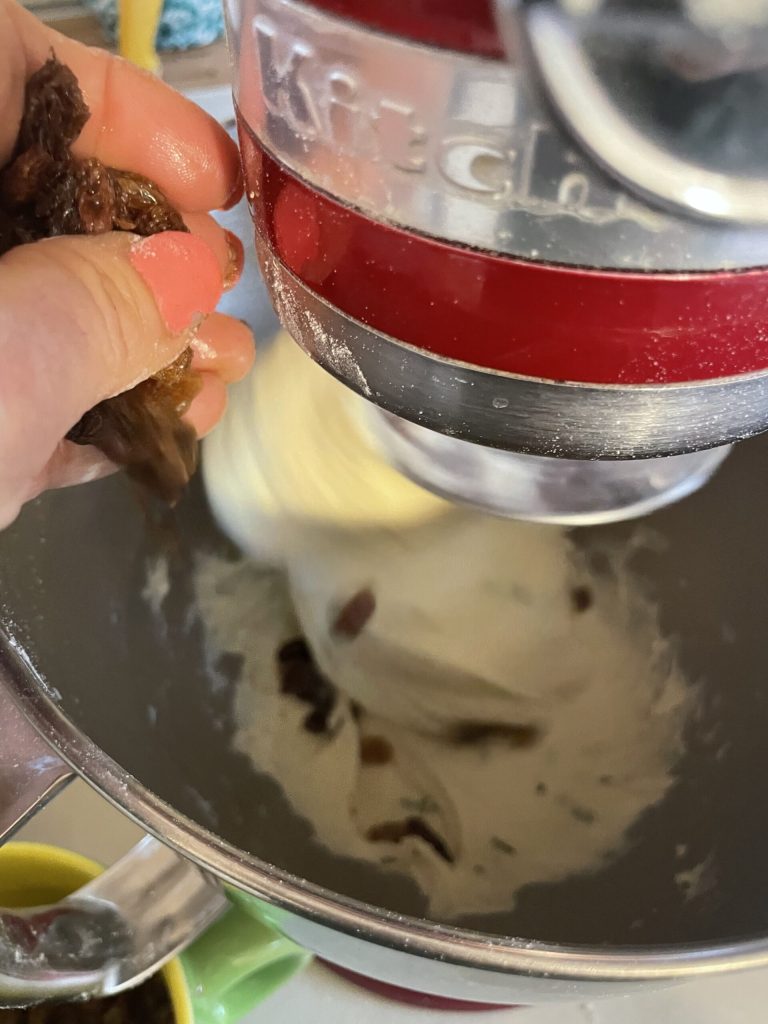
Once finished kneading, form a ball and place everything in a lightly oiled bowl, covered with plastic wrap or a silicone lid. Keep it at room temperature for a couple of hours and then put it in the fridge for at least eight/10 hours. This way, it will mature slowly.
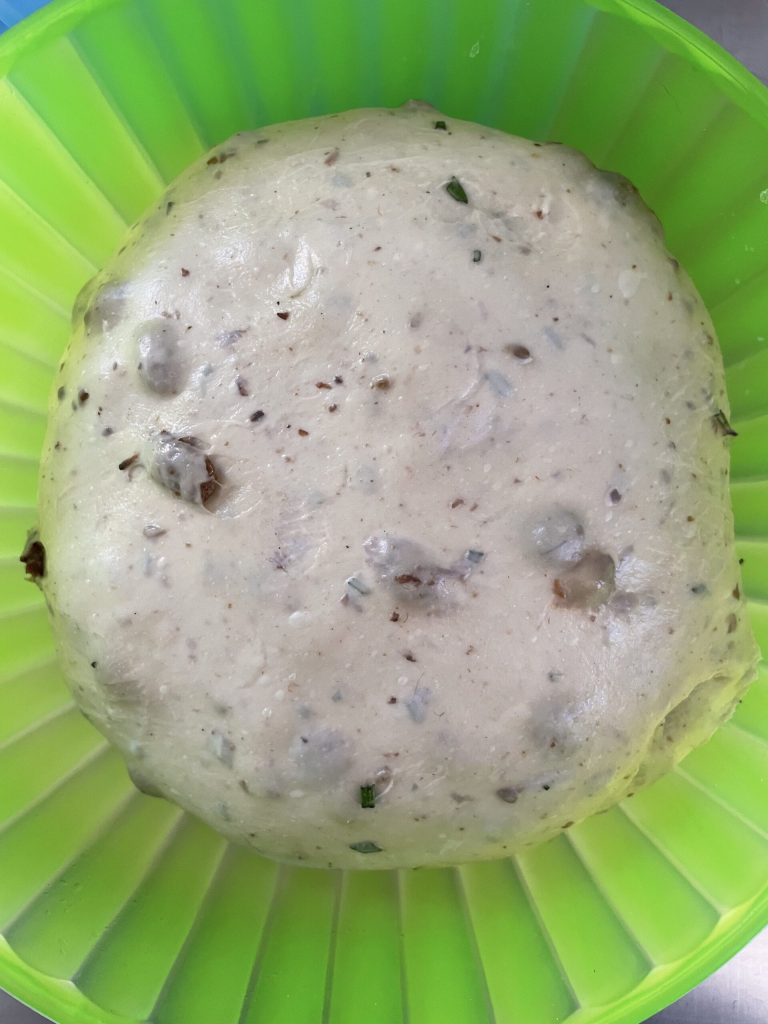
The next morning, take the dough out of the fridge and let it come to room temperature. After at least an hour (although it depends a lot on the room temperature), turn the dough onto a work surface and with the help of a scraper and a scale, portion the dough. I made 13 parts weighing 70/80 grams each, but the rosemary buns in bakeries can weigh more than 100 grams.
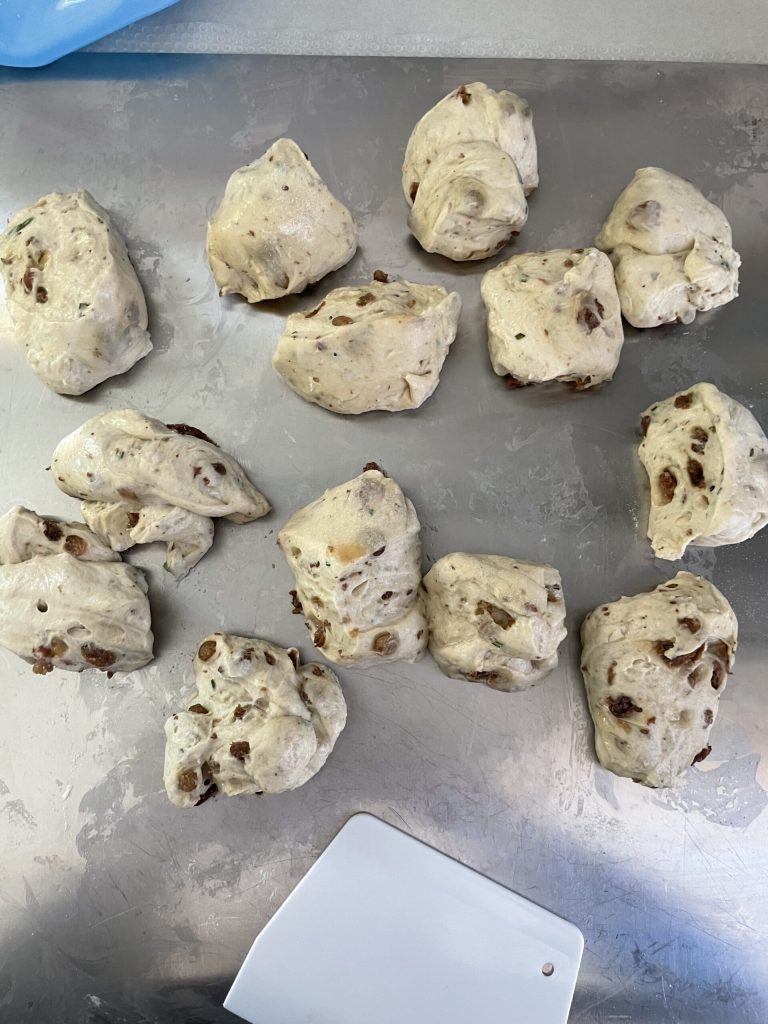
As seen in the sequence, to make the ball, you need to properly spread out the dough and bring the corners to the center twice, ending by pinching everything together in the center to seal.
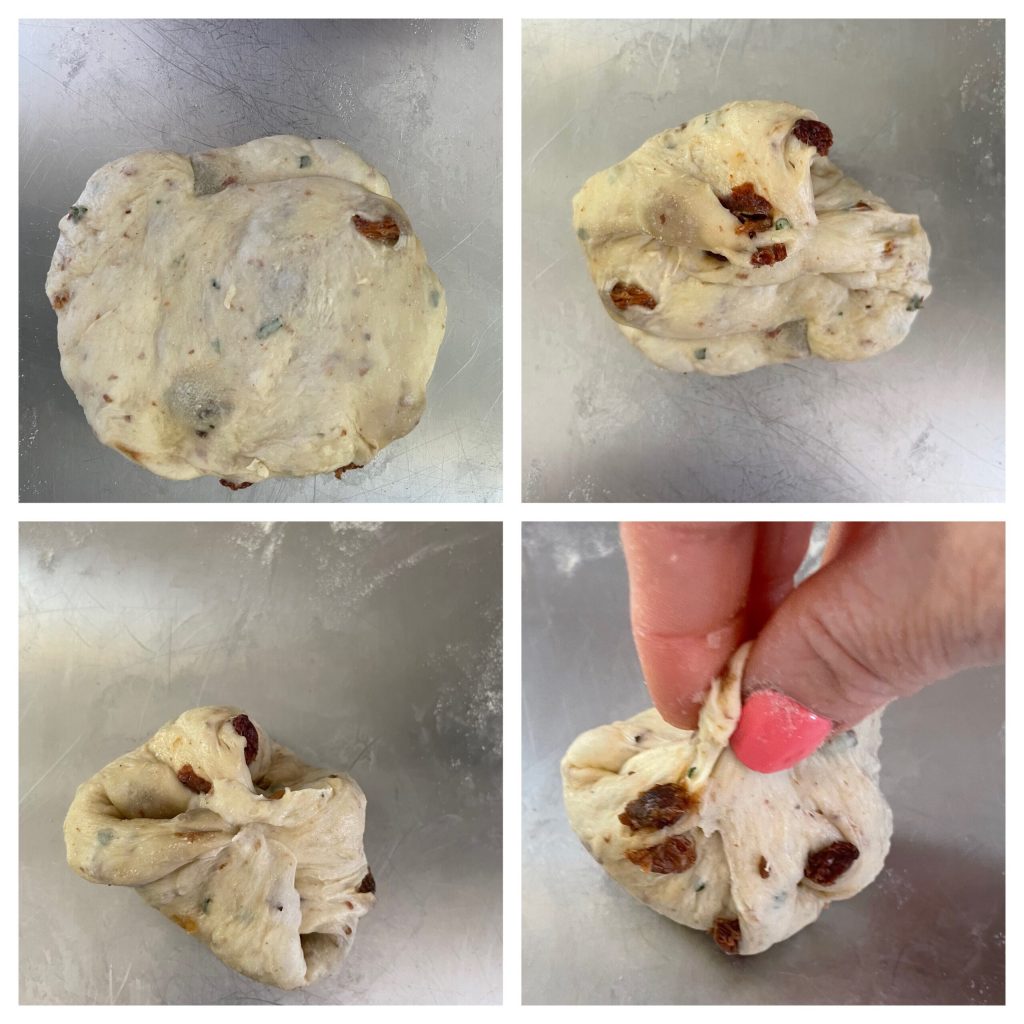
Once the ball is formed, it’s time to round it: as seen in the photo, you need to let it slide on the surface while applying light pressure. I recommend doing this twice because it will make the balls perfect.
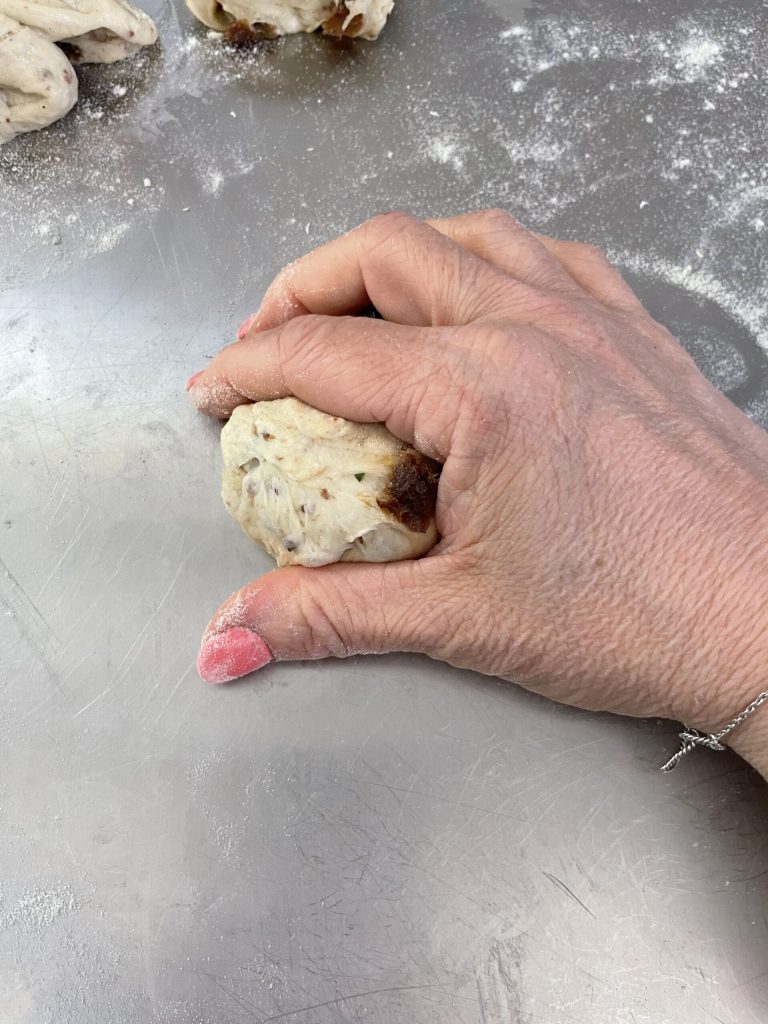
After covering two trays with parchment paper or special silicone mats of silicone, place the balls spaced enough from each other on the baking sheet. I placed 6 on one tray and 7 on another.
Cover with plastic wrap and place in a warm place to second rise. It took me about two and a half hours; it’s better to bake them a bit earlier rather than wait too long; in the first case, it will have the power to grow in the oven, in the second it won’t have the strength anymore.

Set the oven to 356°F (180°C) static mode. Meanwhile, while it heats up, emulsify the yolk and milk in a small bowl. Use a brush to coat all the rosemary buns with sourdough at least twice, to give them a nice rich color.
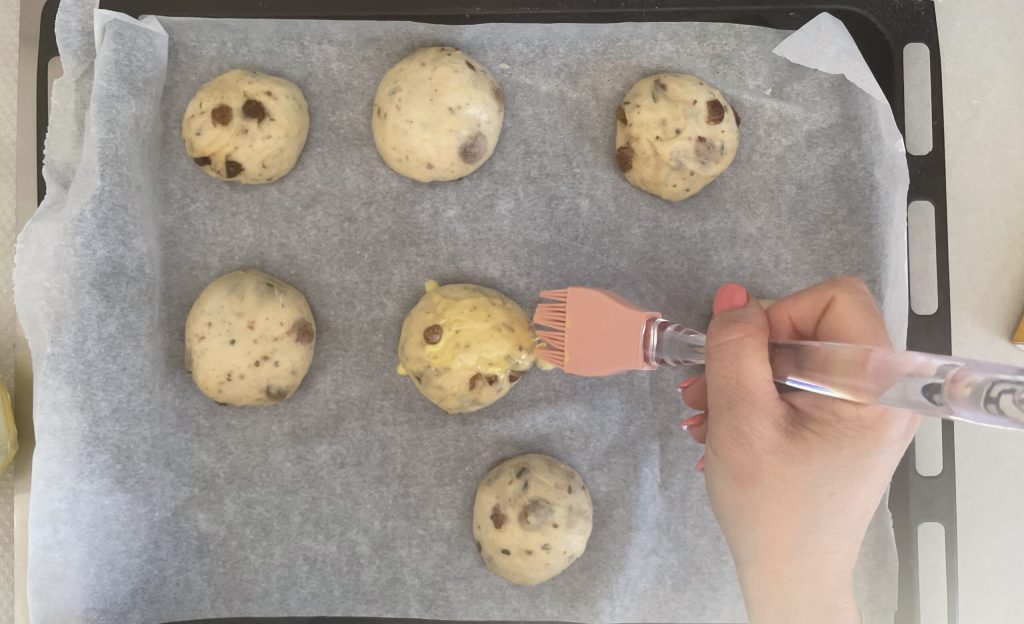
With a bread lame or a very sharp knife make 4 cuts, two horizontal and two vertical, traditionally depicting a double cross. Cover gently with plastic wrap and wait until the oven reaches temperature.
Bake for 25/30 minutes, preferably one tray at a time to cook all the buns evenly.
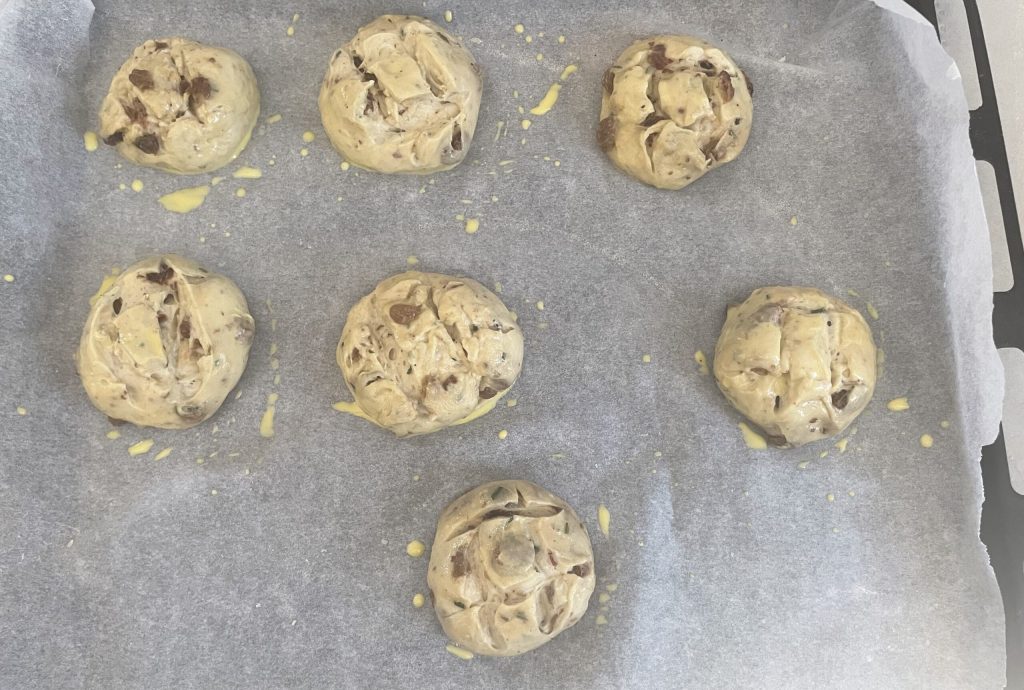
While the rosemary buns are in the oven, in a small jug put 50 grams of water and 50 grams of sugar. Bring to a boil, creating the syrup. As soon as they come out of the oven and are still hot, place the buns on a rack with a plate underneath and drizzle them with the syrup which will then drip all into the plate below. This will create a coating that will make all the buns shiny and sticky, just as tradition wants.

Once they’ve cooled down a bit, place the rosemary buns with sourdough in a basket, ready to offer to guests during Holy Week.
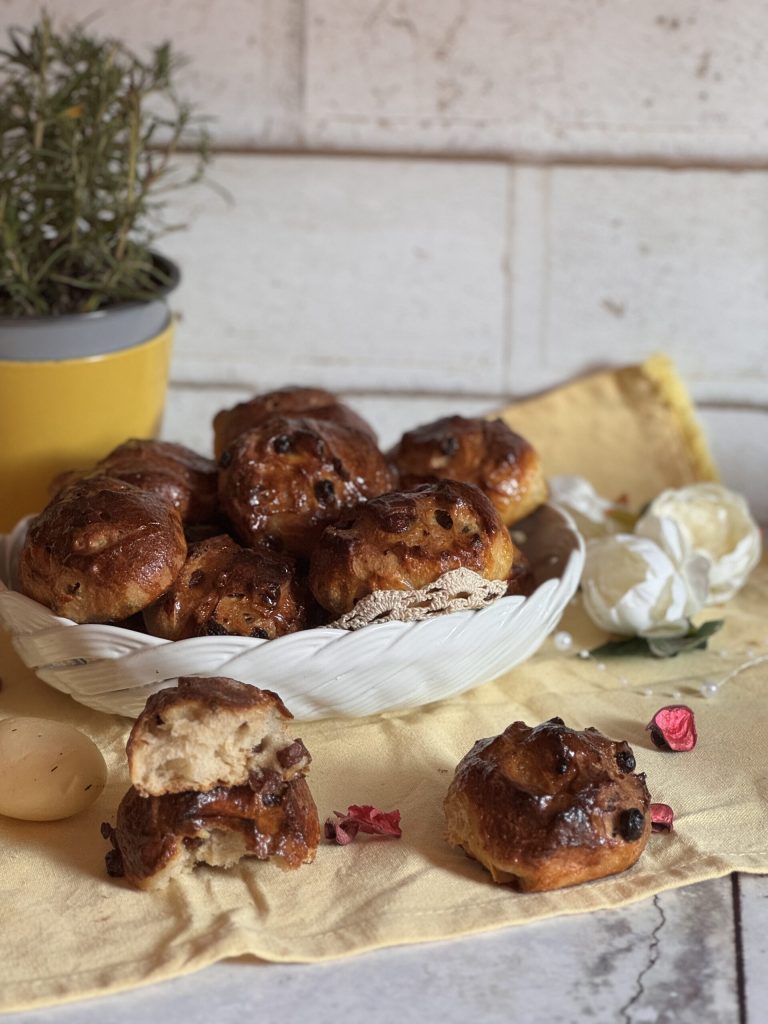
Storage and Notes
The Rosemary Buns with Sourdough keep for 3 or 4 days if wrapped in a cloth or a paper bag. Alternatively, they can be frozen, already cooked, ensuring they are placed in separate bags to avoid freezing together. Simply remove them from the freezer in the morning to have them fresh for dinner. They can be a good idea as a place card at the Easter lunch or a snack to take with you during the Easter Monday outing, you’ll find that once discovered, you won’t be able to do without them! If you liked this recipe, join me on Instagram where I post other recipes and tips and where we can discuss good cooking!
Gluten-Free Rosemary Buns
My colleague Selene created a gluten-free version of the rosemary buns, inspired by my recipe and using her sourdough born from rice flour and a mix of gluten-free flours suitable for baking. Here is the link to her recipe where you will find the process and the specific products she used.


